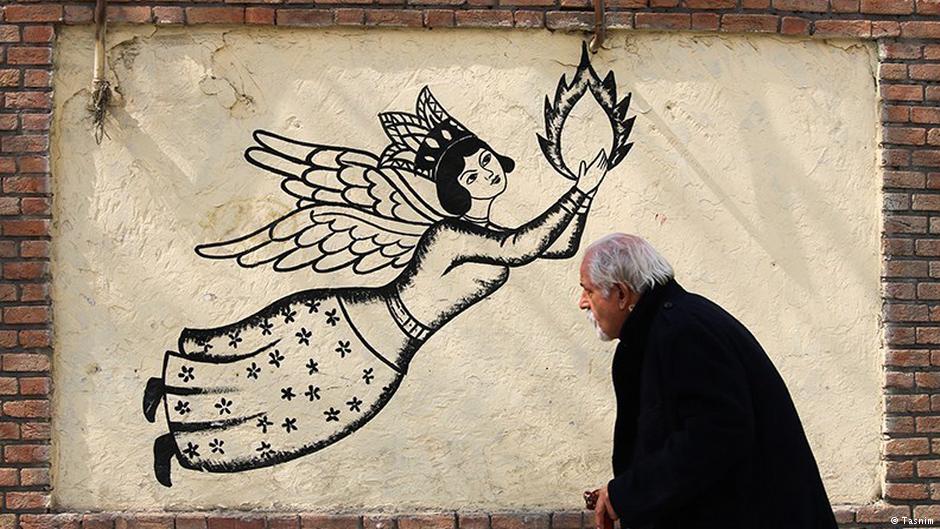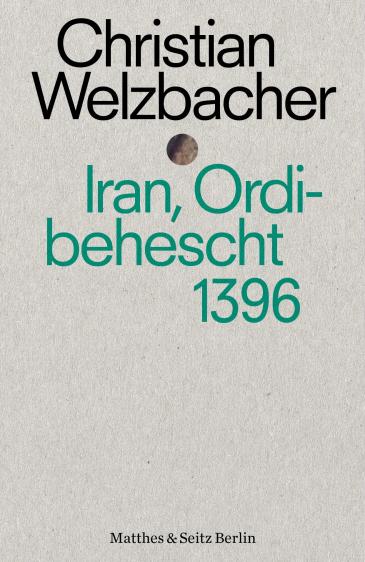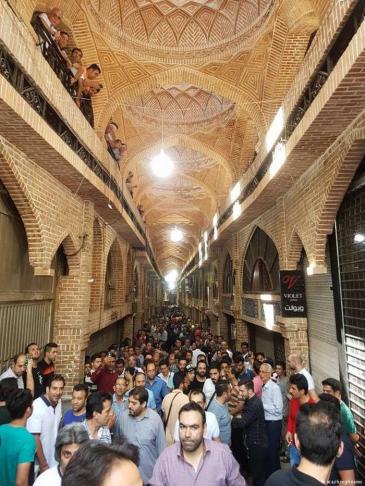Freeloading in Iran

A lot of books and pieces of travel writing about Iran have been published in Germany over the last decade. Most are publications that try to convey a reflective image of the "land of mullahs and the nuclear programme", a long way from official Iranian government policy. This requires thorough preparation and adequate research, so that the authorʹs subjective assessments can be backed up with facts and figures. In short, a plan for the trip and the book.
But recently a Berlin publisher has brought out a travel book about Iran whose author didnʹt originally mean to write it – or to make any notes during his three-week stay in the country: "Iran, Ordibehescht 1396", by the art historian Christian Welzbacher. The title, which is a reference to the Iranian solar calendar, simply means: "Iran, April-May 2017".
"Initially I had no intention of writing anything down. I didnʹt mean to see my observations as ʹmaterialʹ," the author explains (p.167). But after a few days in Iran, Welzbacher changed his mind, recording and interpreting all his thoughts and experiences in Tehran, Isfahan and Tabriz, "page after page, like a real diarist". "Iran, Ordibehescht 1396" is the result of this unplanned – although not unbiased – thematically unconnected record of his trip.
The reason for the trip
The reason for Christian Welzbacherʹs journey to Iran in April 2017 is something we only learn on pages 32 and 115. Here, he tells us he had two obligations to fulfil. The first was to make contact with the Diba architectsʹ office. The office, the author writes, also operates a cultural event agency called Saba, which is interested in international exchange. Welzbacher wanted to meet the head of the practice, the Iranian star architect Leila Araghian, to negotiate bringing an exhibition on contemporary mosque design curated in 2012 for IFA – the German Institute for Foreign Cultural Relations – to Tehran. Since there is no reference to Saba to be found on Dibaʹs current website, it remains unclear who commissioned him with this task.

The second task for which he was issued a work visa by the Iranian embassy in Germany was also related to "mosque design in Europe": Welzbacher was scheduled to give a lecture on the topic at the Islamic University of Tabriz. There is no explanation of how this came about, either. Despite a visa having been issued for the purpose, things do not go smoothly: two hours before the lecture is due to begin, a functionary from the Education Ministry tries to have Welzbacherʹs appearance cancelled. But he doesnʹt succeed, and Welzbacher is able to speak at the seminar and fulfil his obligation.
Nuisance factors without end
When the author is not busy with the above-mentioned "business", he visits museums, mosques and kebab shops, happily eats at his Iranian companionsʹ expense, and is continually annoyed by exhaust fumes, the cacophony of car horns, the stink in the air, "which always stays in your nose like the fine, stale dust from the lime whitewashed walls" (p.46); the harsh sun that bleaches all colours; objects in the capitalʹs sculpture park made of polished steel, "which in summer become as hot as fiery furnaces" (p.46); ugly houses made of glass and concrete, imports from "another world"; the bazaar, which isnʹt exotic enough and in "many respects [is] a modern retail centre, the structures and processes of which are as similar all over the world as the interests behind them” (p.25).
The author also finds peopleʹs attitude to the policies of Iranʹs former president Mahmoud Ahmadinejad "frightening": he cannot comprehend the fact that they hold him responsible for the countryʹs current economic misery. "I hear this talk quite often, not just in the capital, but everywhere my trip takes me. It strikes me that the tirades against Ahmadinejad are always angled in such a way as to apparently increase his successorʹs moral integrity" (p.52).Welzbacher is also of the opinion that the Iranians are not at all hospitable: "The Iraniansʹ much-vaunted hospitality is a cliche, like the Russian soul" (p.127). As evidence of this, he lists incidents like these: "The stroppy conductor on the Tabriz-Tehran sleeper, who held onto my change from the tea for half the night…"
It should be noted, however, that Welzbacher spends his entire trip staying free of charge in a guest apartment belonging to a Diba employee. But he finds plenty to complain about there, too: "The apartment hadnʹt been tidied; before I arrived, tables and low cupboards were piled high with empty biscuit boxes and seltzer bottles…" (p.153). Moreover, he fails to see the services provided free of charge by the Diba employees as hospitality: they accompany him everywhere and "facilitate contacts, make appointments, order taxis, recommend restaurants, answer questions…" (p.33).

Hamam Ingres-style
But there is one place where the author does feel like heʹs in the "East": a teahouse that the Iranians pronounce "Ghaveh-Khane" and which Welzbacher calls "Kafe-Khane". "For the first time, I really feel I have arrived in a foreign world, because it conforms to the idea I came with" (p.25). He sees a teahouse in Tabriz as a symbol for the Middle East, as it "corresponds to the ideas of the East in something like the same way as the hamam in the odalisque images by Dominique Ingres". Why he compares the "Kafe-Khane", where "twelve men with wrinkled workersʹ faces sit at a line of little wooden tables in front of white-tiled walls," with the multi-figured composition of the picture "The Turkish Bath" (more than 24 naked women around a pool) remains unclear.
However, there are numerous passages throughout the book that seem fanciful and opaque, particularly when it comes to conversations with the decision-makers in the Diba architecture practice. Instead of addressing the specific issue and reporting the dialogue relating to it, the author tangles himself up in long, unsatisfactory descriptions and comments which are anything but illuminating: "When I probe further, I receive half-baked explanations. Golineh talks about problems with reaching agreements, with orientation, problems of all kinds. For the first time there is something inexpressible in the air, a sinister gap that casts a shadow over the conversation like a small black cloud…" (p.137). All the author is able to clarify is that the sense and purpose of his visit have still not been fulfilled.
And what is the sense and purpose of this business travelogue? "Iran, Ordibehescht 1396"proves to be a collection of bleak scenes, half-baked comments and observations free from any kind of sensitivity and reflection. It is a travelogue which has been written without any immediate use for the authorʹs notes, set down for the moment, and with a "recurring and sometimes implacable anger" (p.166).
Welzbacher presents the sense and purpose of his book as follows: "Since the trip failed on a business level, it would be a legitimate course of action to make a success of it on a journalistic level, to justify the effort, to give some sense to the costs" (p.169). Given a different outcome, that might have been a legitimate calculation.
Fahimeh Farsaie